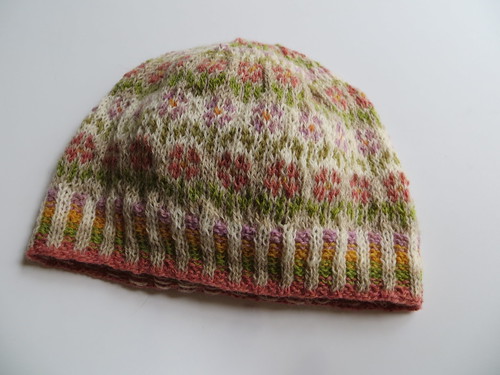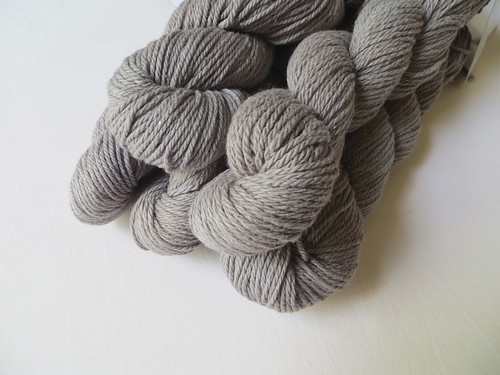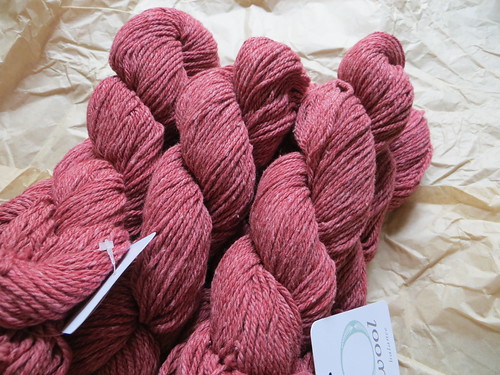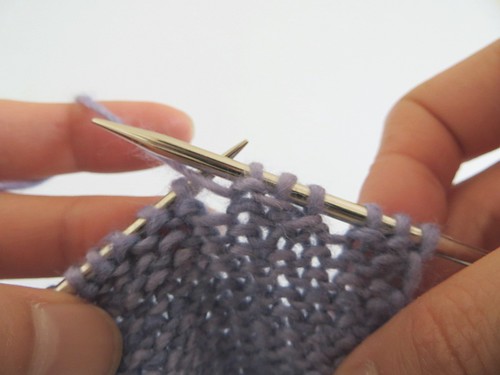Sep 25, 2014
Hari
Where should I begin?
I used for this project Sock from Madelintosh which has less yardage than Tosh Merino Light used in the pattern (and I almost used up the skein, just 30 cm/12" left, that's cool). Because of this and which can often happen with lace projects, my project was really short just after the knitting. I therefore decided to make it a cowl instead of a scarf.
Grafting finished, I first soaked the work, and let it dry on a towel like a pullover. All the spikes were flattened down, it looked like a simple lace cowl... Needless to say I was super disappointed.
Crossing my fingers, I redid the blocking, letting it dry in the shape of spikes. But it's the form of cowl, a large circle, that was hard to manage. Spikes are pointed on the inner side of circle, but flatter on the outer circle. I changed, how to say, the direction? when it was yet wet - inner side on outer side and outer side on inner side.
And it's worked!!
Here's the finished cowl, worn in single circle.
And doubled. I have a little preference for this way, we can see spikes more distinctly and it's easier to wear :)
Notes
Pattern: Hari by Olga Buraya-Kefelian
Yarn: Madelinetosh, Sock: Smokestack
Needle: 3.5 mm/US 4
Ravelry: Tension and Spikes
Sep 22, 2014
Japanese W&T
On RS, as with W&T method, you knit to the turn-back point, slip one stitch, and bring your working yarn in front. I usually replace wrapped st on LN before turning work so as not to lose it.
Turn work and bring back working yarn in front (WS of work now). And - it's the crucial point - slip the first st with yarn in front (photo), instead of purling it.
On the photo, I purled the second st.
And you resolve the gap as W&T method: on RS, you work to wrapped st (photo) and lifting wrap with RN tip, knit together with the st.
Here's the result from WS. Wrap is longer with this technique; yarn goes across slipped sts.
On WS, you proceed as on RS.
You purl to the turn-back point, slip one stitch on RN and bring your working yarn in back. Replace the st on LN, turn work, bring the yarn in back.
And slip the first st wyib (photo).
Here, I knitted the second st.
To resolve the gap, when you come back to wrapped st (photo), lift the wrap onto LN inserting RN tip into wrap from the bottom in back.
Purl the wrap and the st together. That's what you do with W&T!
The result from WS.
And what is striking is that you obtain the same result as Japanese method 2 (slipped st and yo). This is indeed totally logical because, instead of keeping turn loops on the needle with yo, we wrap it around sts. The result on RS is just as neat and what's more, you don't need to reverse YO and st to purl on WS :) Not bad, is it? We can call this way Japanese Wrap & Turn!
To be honnest, I have to add that this result on RS is the same as German short rows technique (or double st) - and conncecting loop on WS is nonexistent with German method, which provides even neater fabric.
But if you're used to W&T, this Japanese W&T is a good compromise!
Sep 12, 2014
Organic Shellseeker
I worked this pullover with an organic cotton-merino blend yarn, it's perfect for half-season as the French say, for Spring and Autumn. I already wore it in some chilly mornings we had in France in August.
The pattern is, as usual for Heidi's patterns, very well written. I like her mathematical way with stitch count given for each section, we're never lost in her patterns. I nevertheless didn't understand the Pocket instructions the first time I read them, and obviously I was not the only one considering the discussion in Heidi's group on Ravelry. I followed the advice given on the forum, that is "follow the instructions", and I've got a nice kangaroo pocket! I think it's a terminological problem, I'd have said Bottom of pocket instead of pocket lining.
Notes
Pattern: Shellseeker by Heidi Kirrmaier
Yarn: O-wool, Balance: Talc & Opal
Needle: US 5 (3.75 mm)
On Ravelry: Douces rayures
Fine days are back in France, I'm knitting another striped but ligther pullover ;)
Aug 23, 2014
Japanese Short Rows?
I was recently in Short Rows Period: my WIPs, discovery of a new method, discussion on Twitter about the best way to wrap sts of W&T, that has given me food for thought.
Here's a little comparative study of different techniques. It's pretty long!
My default method was W&T. As this method is frequently employed in English patterns, I was used to this technique.
But you know, I'm Japanese, I compared it to Japanese methods. Yes, methods in the plural, because there are two.
You've perhaps heard of “the Japanese Short Rows method”, that only uses a slipped st at each turn. This technique only requires split markers (or safety pins, paper clips…) that you put on working yarn to mark the connecting loop. When you get back, you will lift it to resolve the gaps.
Another Japanese method uses YO and slipped st. It's the method Japanese knitters learn first as it's considered easier than "the Japanese Short Rows method". In brief, you make a YO at each turn, turn work and slip the first st of next row.
The thing those two methods have in common is "slipped st" at turns, which results in one less row than W&T method.
Here's the difference expressed in chart:
| W&T | Japanese methods |

|

|
Grey cells indicate what you do (wrap in W&T, yo and slipped st in Japanese methods) and will disappear from RS once you resolve short rows. What we can see with the charts is that the "slope" is smoother with Japanese methods.
With a real yarn, you get this result:
 |
| Malabrigo, Silky Merino: London Sky! |
On this picture, the sts just below short rows are marked with pins: from left to right, Japanese method with yo (method 2), "the" Japanese method (method 1) and W&T. And the row where short rows' gap is resolved is in darker blue. We can see that there are 3 rows between pinned row and dark row with W&T and only 2 rows with Japanese methods.
Then, Japanese methods are superior to W&T? The answer is yes and no.
Yes because the result is neater as I've demonstrated so far. And No because of the "handiness" of W&T: with the method 1, you need split markers or any other similar tool in your hands whereas you just need your needles and working yarn with W&T. As for the method 2, when resolving short rows, you simply knit the YO and the next st together on RS, but on WS, you have to reverse the YO and the next stitch before purling them together – yes, I'm slacker.
Then, what happens when you mix W&T and Japanese methods? That will be the subject of the next post!
Aug 19, 2014
Tender Peerie Flooers

The Supersoft 100% Wool from Holst Garn has got very soft after washing: stitches have become denser and the roughness and itchiness of the yarn disappeared!
The pattern being for adult, the hat needed to be adjusted particularly in height. I started with S size, worked only 3 rows of flowers instead of 4, and rewrote the crown pattern, trying to get motifs that look like little flowers...


My daughter loves it, that's the main thing. Hope she'll wear it this winter!
Notes
Pattern: Peerie Flooers by Kate Davies
Yarn: Holst Garn, Supersoft 100% Uld: Persian Rose, Oatmeal, Calypso, Ecru, Sunrise, Sweet Pea, Verbena, Clementine
Needle: 3.25mm/US 3
Measurements: 47 cm circ x 19 cm depth before blocking, 49 cm circ x 18 cm depth after blocking
On Ravelry: Tender Peerie Flooers
Aug 9, 2014
The most jogless stripes
I'm a stripes lover and don't like seaming. I naturally looked for techniques to work stripes in round. When knitting Paulie cardigan, I came across the TECHknitter's post on the stuff, but after several trials, I gave up knitting sleeves in round and I sewed them!
I recently began (and now finished!) knitting Sheelseeker by Heidi Kirrmaier with Balance from o-wool, a pullover pattern with 2 rnds stripes all over. I remembered that there was a "jogless" stripe technique in a hat pattern I'd translated, Brynja Beret by Hélène Magnússon. I tried it and it worked marvelously fine!
Here's how to proceed (only in text).
1. You work with Color A to the end of rnd (knit the last st).
2. Slip back the last st onto LN.
3. Knit the replaced st with color B, and continue with color B to the last st.
4. At the end of the (first) Color B rnd, with RN tip, lift the Color A st just below the Color B st (both worked in previous rnd) onto LN.
5. You have Color A st and Color B st on LN. Knit these 2 sts together. The Color B st is behind the Color A one and invisible from RS.
This technique is also explained with photos in Hélène's latest book, Icelandic Handknits: 25 Heirloom Techniques and Projects (if you love the Nordic style knitting, you'll find your happiness as French people say ;)).
I all the same show you the result with photo. The arrow shows the end of the rnd. Isn't it great!?
If you've never been satisfied with other techniques, try it!
Jul 25, 2014
Stranded knitting exercise
.JPG)
I thought I seriously needed exercises and decided to restart a long-abandoned project: Peerie Flooers by Kate Davies. I'd immediately fallen in love with this pattern and tried swatches with leftovers from a scarf project (left). The result (right) was rather lovely, but I didn't start the project as I wanted something vivacious like the scarf.


More than two years have passed since then and I've got wise (?), I now appreciate this tender colour combination.
This project was a good exercise for my right forefinger: I usually knit in continental style, but I held contrasting color yarns in English style throughout this project! And to my surprise, I got a better result than the swatch with alpaca yarn.

The yarn I used is Holst Garn Supersoft 100% Wool, that is somewhat rough before washing as you know. I think this roughness worked fine here: fibers of strands hold on, which keeps the fabric from puckering. I have to add that the English style made me knit with a looser tension.


The two sizes of the pattern are for adults, the S size was too tall for my daughter despite less repeats (3 rows of flowers instead of 4). I shortened the hat by rewriting the crown, with free OpenOffice spreadsheet!
I'll post photos of the hat "in practice" soon!
Jun 19, 2014
Leticia
 |
| ©Reiko Kuwamura |
The shawl is worked in a rather unusual way for a shawl, from the bottom up. You first knit the lacy border and pick up stitches along one edge, and the body is shaped with short rows. Its lacy aspect is created with no yo!
 |
| ©Reiko Kuwamura |
Jun 8, 2014
Alla
I love this job because I can take part in "pattern making", think with designers about ways to get instructions clear and easy to follow. And of course, for the privilege of previewing upcoming patterns;)
Today, I'm very happy and proud to introduce you Alla by Hélène Magnússon that I worked on this week!
Alla is a little lacy circular yoke cardigan, light as a feather. It's worked from the top down, with a lace weight yarn and different size needles to accentuate this flared shape. Hélène was inspired by the work of Aðalbjörg Jónsdóttir, an old Icelandic woman who had created beautiful lace dresses, when she was working on a book about her.
The cardigan is very versatile, it can be worn dressed up or down. You can see many examples on Hélène's blog where you can participate to Pinterest giveaway.
The pattern is available on Ravlery or on Hélène's website, The Icelandic Knitter.
Now, I'm going to translate it into Japanese for my e-store ;)
Jun 5, 2014
Tension or Spikes?
I must say it's the most creative pattern I've ever knit!
Here it is.
It looks quite better knitted, I love the changing shades of light grey, Amy is really talented!
May 27, 2014
Olive Larch
I share the photo of the yarn as its color is the closest one.
It's very classically worked from the bottom-up with set-in sleeves, but remarkable for the originality of the collar. And I love the result!
It might seem simple and easy with st st and 1x1 ribbing, but it is deceptively. The ribbing is twisted, imagine knitting and purling all sts through back loop! And I have to add that there are not a few mistakes in the pattern... If you're used to knit clothes, it's not hard to realize them. But isn't it however frustrating and all the more regrettable because the design is really nice? I listed them up on my Project page, hope it will help you.

Another photo of the cardigan with the closest color on me.
NOTES
Pattern: Larch Cardigan by Amy Christophers
Yarn: Drops, Alpaca: #7233
Needle: 3.5mm (US 4)
Ravelry page: Olive Larch
May 22, 2014
Ecological Yarn 1
After a long wait which had worried me, the parcel from the USA has arrived on Monday! The reason of the delay is the strike of postmen (and women) in my city that had been lasting 2 weeks, yes, ça, c'est la France!
The parcel contained "American" ecological yarn. It's often said that a picture is worth a thousand words, here are the photos.
 |
| Opal |
 |
| Talc |
 |
| Ruby |
These are Balance skeins from o-wool, balance between organic cotton and merino. This composition, perfect for transitional months, is rather rare in France, I was happy when I found it (on Ravelry search engin).
I chose this yarn for spring/autumn projects in my Queue, but the purchase was also motivated by the environmental and social commitment of the owner Jocelyn! All her yarns are made - scoured, spun, dyed - in the USA with products and process certified green, to perpetuate, even on a small scale, the local textile industry.
And half of the raw material - organic cotton - of this yarn comes from the USA, while organic merino from South America, hence my caution. The Americas are vast, compared to France, or Japan... That said, I fully support her initiative!
I'm so looking forward to knitting Shellseeker by Heidi Kirrmaier, in this soft color combination!

May 19, 2014
Hello! - Basic and Nice Ribbed Socks
It's finally happened, I have a blog in English. It will be a notebook of my projects, the yarns and books I'll get, my work, etc., all about the knitting!
For the first post, I start with my latest finished object. It all began with the yarn I didn't know what to make with.
Here it is.
 |
| Dream in Color, Smooshy : Chinatown Apple |
I bought it to make Pogona shawl of Stephen West, but I couldn't resist the temptation to knit this shawl with Madelinetosh Sock in Calligraphy (how can I?) that I purchased at the same time. This skein started its long sleep of hibernation.
I recently decided to wake it up, it's a shame to leave a Smooshy skein aside, isn't it? For this fingering yarn with a light color variation, I thought of socks with simple stitch to show it off. I set my heart on Basic Ribbed Socks and A Nice Ribbed Socks, both in 3x1 ribbing and free on Ravelry. I finally mixed two patterns and incorporated another recipe from a Japanese book.
It's fun to knit socks, they rapidly take shape, in 3D! And the yarn is lovely to work with. I have to say that it's not so soft despite of the fiber used - 100% merino - , but smooth, bouncy, perfect for making socks. I'm quite satisfied with the result, we can see the changing colorway.

The only snag is that you see two points at toe as they're grafted with kitchener stitch there. I've understood why toe-up socks were invented. I'll try this type next time!
Notes
Pattern: A Nice Ribbed Socks & Basic Ribbed Socks
Yarn: Dream in Color, Smooshy: Chinatown Apple
Needles: 2.5mm (US 1½) DPNs
I've just taken some pictures of another fo. I'll post them shortly!




















